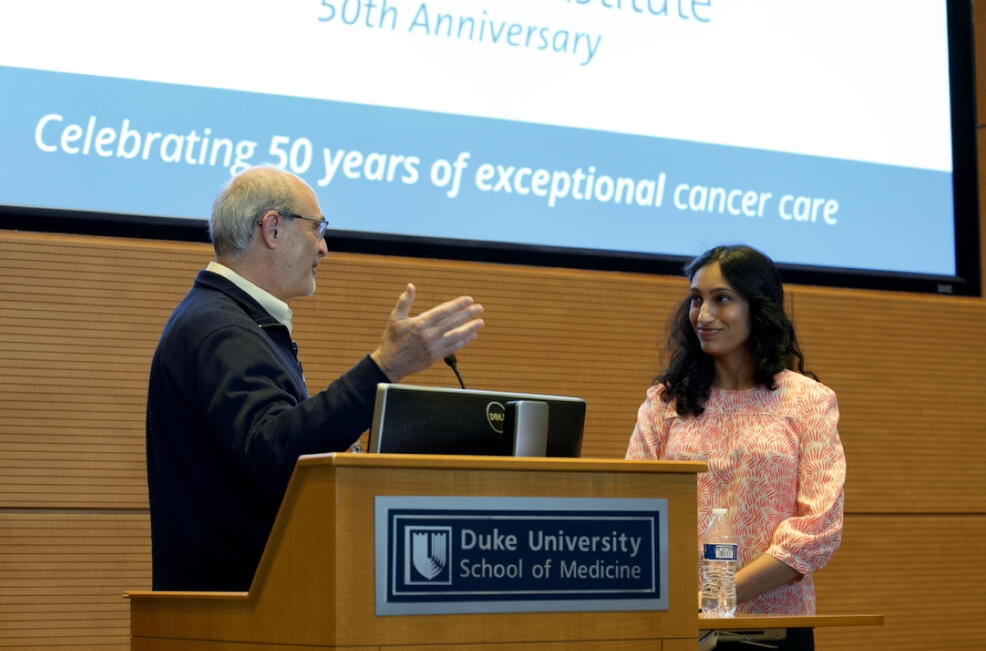
For the first time since 2019, the Duke Cancer Institute Scientific Retreat was held in person with a full program followed by a poster session and mingling. Held on December 2, 2022, the retreat attracted around 90 faculty, staff, and trainees (students, residents, fellows, postdocs, etc.).
There was also a virtual option, which an additional 184 individuals took advantage of — whether out of convenience or caution during a season of rising Covid-19, Flu, and RSV infections.
“Good afternoon, everybody. It's a pleasure to welcome you to the ninth annual Duke Cancer Institute Scientific Retreat. It's wonderful to be able to be in person again. I know this is a hybrid meeting, so we don't have everyone here. Maybe 15% of the audience is in person — but this is better than zero," said Executive Director of Duke Cancer Institute and host of the event Michael B. Kastan, MD, PhD. "We have a wonderful afternoon planned with selections of the top abstracts from each of the Cancer Center programs, a faculty presentation by Dr. Epplein that we're very much looking forward to, and then our keynote speaker for the Colvin lecture, Peggy Goodell from Baylor will be wrapping up the afternoon prior to the poster session.”
Commemorations of DCI's 50th Anniversary as a National Cancer Institute-designated Comprehensive Cancer Center were in evidence in nearly every presenter’s PowerPoint — emphasizing their pride in the tremendous impact of current and former DCI investigators and clinicians on cancer research and patient care in the U.S. and around the world.
Seven DCI Trainee Members — one from each of DCI's seven basic, clinical, and translational National Cancer Institute-Designated Research Programs — were selected by program leaders and the scientific review committee to present their research at the retreat. (Previous to the retreat all trainees were invited to submit, for oral-presentation consideration, an abstract on their research project).
Six of the trainees received a $1,000 award from the DCI and the trainee with the most innovative basic-science research project, as is customary at the annual retreat, received the Robert and Barbara Bell Basic Science Cancer Research Award in the amount of $5,000.
Each trainee was introduced by either their mentor or a research-program faculty leader and took questions after their presentation. Between affirmations, friendly critiques, probing questions, and ideas for further exploration, there was no debating that the learning was infectious.
In three presentations, the learnings were literally “infectious.”
Meira Epplein, PhD, MS, MA — co-leader with Katherine Garman, MD, of the National Cancer Institute-designated DCI Cancer Risk, Detection and Interception Research Program (CRDI) — plus two of seven top trainees addressed, each from different angles, the bacterial and viral associations with and molecular drivers of gastric cancer, and potential strategies for both treating it and stopping its development before it starts.
Other topics of the afternoon included:
- a patient experience study on barriers and facilitators to care in Black patients with newly diagnosed leukemia (specifically AML);
- a pathology/immunochemistry computational mapping study — deep learning — to characterize the features of the immune micro-environment landscape;
- novel approaches for: targeting fusion-driven rhabdomyosarcomas; targeting glioblastoma stem cells, otherwise known as brain-tumor initiating cells; and making breast cancer more receptive to treatment with immunotherapies by using targeted therapy/vaccination
- and a review, by the keynote speaker, of the mechanisms that regulate hematopoietic stem cells and how they go awry in blood cancers
















